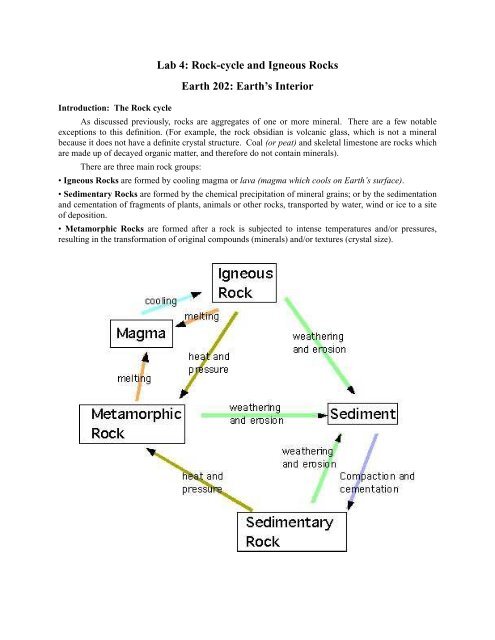Lab 4: Rock-cycle and Igneous Rocks Earth 202: Earth's Interior
Lab 4: Rock-cycle and Igneous Rocks Earth 202: Earth's Interior
Lab 4: Rock-cycle and Igneous Rocks Earth 202: Earth's Interior
Create successful ePaper yourself
Turn your PDF publications into a flip-book with our unique Google optimized e-Paper software.
Introduction: The <strong>Rock</strong> <strong>cycle</strong><br />
<strong>Lab</strong> 4: <strong>Rock</strong>-<strong>cycle</strong> <strong>and</strong> <strong>Igneous</strong> <strong>Rock</strong>s<br />
<strong>Earth</strong> <strong>202</strong>: <strong>Earth</strong>’s <strong>Interior</strong><br />
As discussed previously, rocks are aggregates of one or more mineral. There are a few notable<br />
exceptions to this definition. (For example, the rock obsidian is volcanic glass, which is not a mineral<br />
because it does not have a definite crystal structure. Coal (or peat) <strong>and</strong> skeletal limestone are rocks which<br />
are made up of decayed organic matter, <strong>and</strong> therefore do not contain minerals).<br />
There are three main rock groups:<br />
• <strong>Igneous</strong> <strong>Rock</strong>s are formed by cooling magma or lava (magma which cools on <strong>Earth</strong>’s surface).<br />
• Sedimentary <strong>Rock</strong>s are formed by the chemical precipitation of mineral grains; or by the sedimentation<br />
<strong>and</strong> cementation of fragments of plants, animals or other rocks, transported by water, wind or ice to a site<br />
of deposition.<br />
• Metamorphic <strong>Rock</strong>s are formed after a rock is subjected to intense temperatures <strong>and</strong>/or pressures,<br />
resulting in the transformation of original compounds (minerals) <strong>and</strong>/or textures (crystal size).
-2-<br />
All rock types are connected by the rock <strong>cycle</strong> model, first recognized by James Hutton. In this<br />
model, all rocks can be formed, transformed, destroyed <strong>and</strong> re-formed from one type to another, over <strong>and</strong><br />
over again. For example, a cooling magma forms an igneous rock. This igneous rock can be uplifted,<br />
exposed on <strong>Earth</strong>’s surface, <strong>and</strong> subccumed to erosion or chemical decay. The rock is broken down into<br />
fragments, or sediments, which are transported away <strong>and</strong> eventually deposited. The sediments become<br />
lithified either by compaction, or natural cementation from crystals precipitated in the water, <strong>and</strong> form a<br />
sedimentary rock. If the sedimentary rock is then subject to intense pressures <strong>and</strong> temperatures, it will<br />
become transformed (in shape, color, density, composition) into a metamorphic rock. If this rock is then<br />
subjected to even more intense heating, it will melt, forming another body of magma.<br />
Questions<br />
i. Use the rock <strong>cycle</strong> model to explain how ametamorphic rock could become a sedimentary rock. Likewise,<br />
explain how asedimentary rock could become an igneous rock.<br />
<strong>Igneous</strong> <strong>Rock</strong>s<br />
Crustal rocks on <strong>Earth</strong> are formed from material which comes from <strong>Earth</strong>’s mantle, in addition to<br />
smaller fractions coming from space (as meteorites), living organisms, or as fragmented pieces of other<br />
rocks. <strong>Igneous</strong> rocks make up95% of <strong>Earth</strong>’s crust, sedimentary <strong>and</strong> metamorphic rocks are derived by<br />
various methods of reworking igneous rocks. Therefore, since we are interested in the gross properties of<br />
<strong>Earth</strong>’s interior, tounderst<strong>and</strong> the composition of <strong>Earth</strong>’s crust we will focus our attention on igneous<br />
rocks.<br />
<strong>Igneous</strong> <strong>Rock</strong>s are classified primarily on the basis of their texture (crystal sizes) <strong>and</strong> composition<br />
(mineral content).<br />
Cooling Rate <strong>and</strong> Crystal Size: Before we learn how toidentify igneous rocks, we will first demonstrate<br />
how the rate of cooling affects the size of mineral crystals. We will use a heated mixture of Epsom Salts<br />
<strong>and</strong> water (representing magma) <strong>and</strong> cool samples of this solution at three different rates.<br />
ii. Predict how crystal size relates with the rate of cooling. By cooling our melt in a bath of warm tap<br />
water, doyou expect the rate of cooling to be faster or slower? Compared to cooling our melt in water<br />
with ice cubes, <strong>and</strong> water at room temperature, which process do you expect to generate larger crystals?<br />
Experiment: Using three beakers, fill one with warm tap water, one with room temperature water, <strong>and</strong> the<br />
last with ice water. Tocreate the "magma", mix Epsom Salts with an equal volume of warm water. Mix<br />
the solution so that salts are completely dissolved. Using three test tubes, pour in each an equal volume of<br />
the "magma" mixture. Next, place a test tube in one of each of the beakers.<br />
iii. Compare the crystals sizes in all three samples.
-3-<br />
iv. How would you change this experiment to generate even larger crystals?<br />
The size of crystals in an igneous rock is an important indicator of the conditions where the rock formed.<br />
If the magma cools extrusively, ornear the surface of the <strong>Earth</strong>, this process occurs at lower temperatures.<br />
In this situation, the crystals do not have much time to form, so they are very small. If the magma cools<br />
intrusively, ordeep inside the <strong>Earth</strong>, the temperature is much warmer. The cooling process takes place<br />
more slowly, <strong>and</strong> the crystals have time to grow <strong>and</strong> become large. When magma flows on the surface of<br />
the <strong>Earth</strong>, this lava cools suddenly, oris quenched, <strong>and</strong> there is no time for crystals to form (this is how<br />
obsidian, volcanic glass, develops).<br />
Bowen’s Reaction Series <strong>and</strong> Composition: When magma cools, crystals form because the melt is supersaturated<br />
with respect to a particular mineral. Ascientist by the name of Bowen noticed that there was a<br />
particular order in the succession of mineral crystallization, where different crystals form from the melt at<br />
different temperatures. He devised Bowen’s Reaction Series, which is a representation of this order of<br />
crystallization <strong>and</strong> how itdepends on the temperature within the magma. Dense, "mafic" minerals, rich in<br />
Mg <strong>and</strong> Fe, would crystallize first, at the highest temperatures. Later, atlower temperatures, less dense<br />
"felsic" minerals could crystallize. This reaction series is also reversible, so if a rock is subject to extreme<br />
temperatures, the first minerals to melt are the felsic ones.<br />
Mafic minerals, such as olivine <strong>and</strong> pyroxene, are also referred to as ferromagnesians based on their<br />
composition. Since these minerals are darker in color, igneous rocks containing them will be darker.<br />
Likewise, felsic minerals such as quartz, alkali feldspar <strong>and</strong> muscovite, are referred to as non-ferromagnesians.<br />
<strong>Rock</strong>s containing nonferromagnesians are more silica-rich <strong>and</strong> lighter in color.
-4-<br />
Using a color index, such as the one below, it ispossible to identify igneous rocks based on their<br />
relative abundance of silica <strong>and</strong> dark colored minerals.<br />
<strong>Rock</strong> Identification<br />
In the next part of this lab, we will use a color index, to quantify the amount of silica in various<br />
samples of igneous rocks. We will then classify rocks as either felsic (acidic), intermediate, mafic (basic),<br />
<strong>and</strong> ultra-mafic (ultra-basic). Next, we will look at the crystal size <strong>and</strong> determine if the rock formed intrusively,<br />
orextrusively. Last, we will assign rock names to the samples.<br />
Sample # Main Minerals Color Index Intrusive or extrusive <strong>Rock</strong> Name<br />
Quartz, Alkali feldspar, Plagioclase acidic Intrusive Granite<br />
(minor: biotite, hornblende)<br />
Quartz, Alkali feldspar, Plagioclase acidic Extrusive Rhyollite<br />
(minor: biotite, hornblende)<br />
Plagioclase Feldspar intermediate Intrusive Diorite<br />
(minor: quartz, biotite, hornblende)<br />
Plagioclase Feldspar intermediate Extrusive Andesite<br />
(minor: quartz, biotite, hornblende)<br />
Plagioclase feldspar, Pyroxene basic Intrusive Gabbro<br />
(minor: olivine)<br />
Plagioclase feldspar, Pyroxene basic Extrusive Basalt<br />
(minor: olivine)<br />
Pyroxene, Olivine ultra-basic Intrusive Peridotite<br />
Olivine ultra-basic Intrusive Dunite<br />
v. Can you think of a scenario in which both large <strong>and</strong> small crystals can be formed in an igneous rock?













